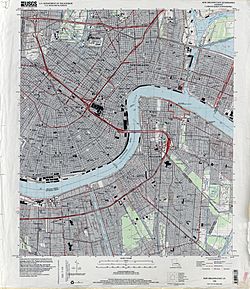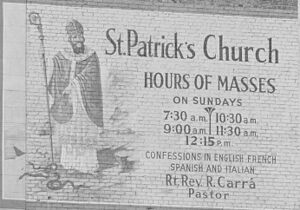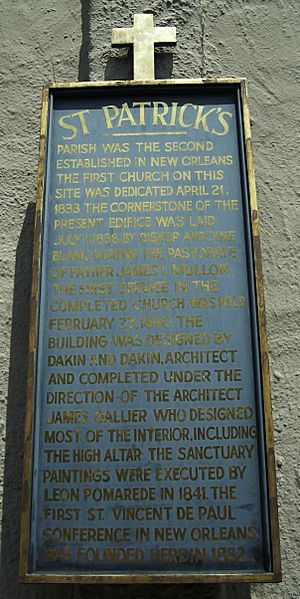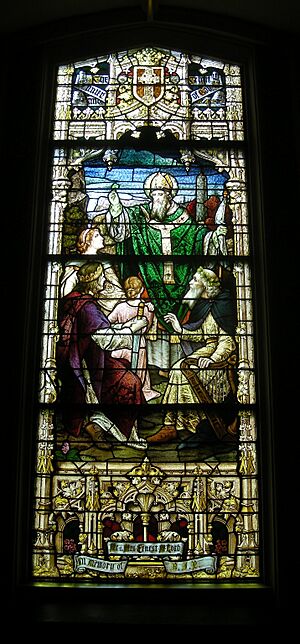St. Patrick's Church (New Orleans, Louisiana) facts for kids
|
St. Patrick's Church
|
|

St. Patrick's Church, 724 Camp Street; parish rectory to the right
|
|
| Location | New Orleans, Louisiana |
|---|---|
| Built | 1837 |
| Architect | Dakin & Dakin; Gallier, James Sr. |
| Architectural style | Gothic Revival |
| NRHP reference No. | 74000936 |
Quick facts for kids Significant dates |
|
| Added to NRHP | May 30, 1974 |
| Designated NHL | May 30, 1974 |
St. Patrick's Church is a beautiful Catholic church in New Orleans, Louisiana. It is one of the oldest churches in the city. The church was started in 1833, and the building you see today was finished in 1840. It is the second-oldest church parish in New Orleans. The oldest is St. Louis Cathedral. St. Patrick's Church is located at 724 Camp Street, in an area now called the Central Business District. This building is a very important National Historic Landmark. It is known as one of the best and earliest examples of Gothic Revival architecture in the United States.
Contents
The Story of St. Patrick's Church
New Orleans first grew outside its original area, the Vieux Carré (French Quarter). This new area, called Faubourg St. Mary, began after 1788. Today, it is part of the city's main business and warehouse areas. Many people called Faubourg St. Mary the "American Quarter." This was because it was different from the French Quarter.
In the early 1800s, many Irish immigrants came to New Orleans. These English-speaking Catholics settled in the new business area of Faubourg St. Mary. The city's population was changing. Before, most Catholics in New Orleans were Creoles. These were descendants of French, Spanish, and African settlers. By the 1830s, a new church was needed for people who spoke English.
In 1833, Bishop Leo-Raymond de Neckere started a new church parish in Faubourg St. Mary. He named it St. Patrick's Church. Building the church began a few years later and was completed in 1840. From 1849 to 1851, St. Louis Cathedral was being rebuilt. During that time, St. Patrick's Church served as the main church for the diocese.
The years after the church was built were sometimes difficult. There was violence against immigrants by a group called the Know Nothing Party. Father James Mullon was the pastor of St. Patrick's Church then. His picture hangs in the church today. He was a very important person in the city. Some people worried that he and the Irish were gaining too much power.
St. Patrick's Church remained a strong center for the local Catholic community. This was true even during tough times. One such time was the American Civil War. New Orleans was occupied by Union troops. Their leader was Major General Benjamin Butler, who was not popular. During the war, Father Mullon was very outspoken. He had been pastor for many years. General Butler once confronted him for not leading the funeral of a Union soldier. Father Mullon famously replied that he would gladly lead the funerals of Butler and all the Union troops.
In 1975, the church building was named a National Historic Landmark. A big restoration project took place from 1978 to 1990. This work helped save the building. It allowed the church to keep serving the people of New Orleans for many more years.
St. Patrick's Church and Hurricane Katrina
St. Patrick's Church is located on higher ground near the river. Because of this, it was not flooded during Hurricane Katrina in 2005. The church building did not suffer much damage. However, many people who went to the church were forced to leave New Orleans. They were scattered like everyone else.
St. Patrick's Church and St. Louis Cathedral are the two oldest churches in New Orleans. They held the first church services in New Orleans after Hurricane Katrina. This happened on Sunday, October 2, 2005. The New York Times newspaper reported on the reopening of both churches. One person who attended said about the church bell ringing, "You can call this a homecoming bell for New Orleans. We have good news we want to get out."
The Design of St. Patrick's Church
St. Patrick's Church is built in the Gothic style. Its outside looks fairly simple. But the inside is very fancy and detailed. The doorways, windows, organ, and altar all fit the Gothic design. The bell tower is 185 feet (56 m) tall. In the 1800s, some pictures of New Orleans were painted from its roof. The main part of the church, called the nave, is 85 feet (26 m) tall inside.
Thin columns hold up the fan-shaped vaulting of the ceiling. This ceiling is especially detailed above the altar. It has sixteen stained glass windows in a half-dome shape. Above the altar are three large paintings. From left to right, they show: Saint Patrick, the Transfiguration of Jesus, and Jesus Christ pulling Saint Peter from the sea.
The main architect for St. Patrick's Church was James H. Dakin. He designed many buildings in Louisiana. One of his other famous designs is the Old Louisiana State Capitol in Baton Rouge. New Orleans has a very high water table. This caused problems during construction. So, another well-known local architect, James Gallier, was brought in to help finish the building.
Where to Find St. Patrick's Church
St. Patrick's Church is on Camp Street in New Orleans. It is located between Julia and Girod Streets. You can easily walk to it from downtown hotels and the French Quarter. It is less than half a mile from Canal Street.
The church is in the middle of what is now an arts district. There are many small art galleries nearby. The Ogden Museum of Southern Art is also in the surrounding blocks.
See also
 In Spanish: Iglesia de San Patricio (Nueva Orleans) para niños
In Spanish: Iglesia de San Patricio (Nueva Orleans) para niños







